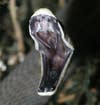All it takes is a pinch on the leg from a sting or a bite, and you could be dead within minutes. Venom, whether it’s from reptiles, insects, fish, mammals or arthropods, is extremely potent, but it’s not always deadly.
Venom has evolved independently countless times; such diverse organisms didn’t branch out from one venomous ancestor, so each species has evolved on its own. As a result, depending on the species, each venom contains a different chemical cocktail perfectly designed to attack the animal’s typical prey. The result is a huge number of chemicals not found anywhere else in nature, which can affect the blood, muscles or central nervous system. Scientists have discovered a huge range of applications for these chemicals, from medicine to explosives and beyond.
See just a few of their important uses in this gallery.
Treating Cancer
Venom from rattlesnakes contains a chemical called crotoxin. Crotoxin is toxic to cells, but it only works on particular kinds of cells—in snake venom, those are in the blood and muscles. Researchers harnessed the unique combination of targeting and toxicity in crotoxin to create a cancer treatment, called CB24, which finds and kills tumor cells that are growing out of control. Initial trials seemed promising, though CB24 is not yet commercially available (its last clinical trial was in 2002).
Mexican redknee tarantula (Brachypelma smithi)
When your body feels pain, cells in your central nervous system receive pain signals through specialized pathways in cell membranes called sodium channels. Block too many sodium channels for too long, and cells become paralyzed, unable to regulate the body’s essential functions. But if you block just the right number and type of sodium channels, the body keeps working as it should, and the pain signals are dampened. While some painkillers go for quantity, spider venom goes for quality, blocking specific sodium channels. Researchers are working with venom from spiders like tarantulas to create painkillers with fewer side effects.
Reduce blood pressure
In the 1970s, scientists created one of the first medications based on the chemical properties of venom. The venom of the Brazilian pitviper contains a protein that disrupts the angiotensin-converting enzyme (ACE), which raises blood pressure in humans and mammals. Researchers converted the venom into a non-toxic ACE-blocker, used to treat high blood pressure. Today, millions of Americans take ACE-blockers, which also reduce the risk of kidney disease, stroke, and diabetes
Central nervous system disorders
The black mamba snake, which resides in African savannahs, can kill a person with just two drops of its venom. Its potency resides in its neurotoxins, chemicals that impair the central nervous system. Fascinated by how these chemicals bind so tightly to nerve cells, researchers at Puerto Rico’s Universidad Central del Caribe are investigating how these chemicals work in order to use them in future treatments for diseases that break down the brain and nervous system, such as Alzheimer’s and Parkinson’s.
Make the brain light up
For decades, scientists have used venom to get a better sense of how chemicals bind to cells and how that, in turn, affects how nerve cells communicate with one another. In the 1960s, they discovered the mechanism behind a muscular disease called myasthenia gravis by using the venom from the Taiwan banded krait. But just last year, researchers at the University of California, Davis used fluorescent tarantula venom to light up live nerve cells. They did it to better understand the changes in electrical charges in the cells; when the electrical channel that allows potassium into the cell was closed, the fluorescent chemical would light up and would dim when it was open. In the future, this information could help researchers better understand the electrical regulation in cells, related to conditions like epilepsy and cardiac arrhythmias.
Kill parasites
Leishmaniasis is a really nasty disease. It can shut down a person’s internal organs, killing them, or cause huge, unsightly skin sores that leave scars. It’s caused by a protozoan of the Leishmania genus, put into humans’ bloodstreams by sandflies’ bites. Medicine can usually get rid of the microorganisms, though it is becoming more resistant to drugs. A team of Brazilian researchers has been using a chemical called crovirin found in the venom of prairie rattlesnake to kill Leishmania protozoans, as well as others in its family that cause other “neglected” infections such as Chagas disease and sleeping sickness. The researchers hope the chemical can be used in new medicine for these diseases in the future.
Detect explosives
After 9/11, lots of people have gotten more worried about explosives, which have become extremely sophisticated. And that means that scientists have been hard at work figuring out how to identify them. A few years ago, researchers at MIT developed a new technique for detecting explosive molecules using carbon nanotubes coated with a peptide found in bee venom—the chemical cocktail that makes bee stings hurt so much. When an explosive material is around, the peptides change the color of the sensor, which works better than other sensors that just light up. Though the sensor still has many limitations and won’t be found in airports anytime soon, it’s much more sensitive than any other technique.
Slow the onset of muscular dystrophy
Boys with muscular dystrophy gradually get weaker—many lose the ability to walk, swallow or talk. The disease is genetic, has no cure and is often fatal. But researchers at SUNY University at Buffalo School of Medicine are developing a drug from a chemical found tarantula venom that may slow the progression of the disease. In a person that has the disease, muscles get weaker because the cell membranes let in too much calcium. But the chemical AT-300, found in tarantula venom, stops the influx of calcium. The researchers hope to start clinical trials in humans sometime this year.
Make batteries
Ionic liquids are substances that act as catalysts for electronics. Today, they are used in batteries and as industrial solvents. First synthesized in the late 1800s, scientists assumed that ionic liquids didn’t exist in nature. But just last year, researchers found that a combination of venom from fire ants and crazy ants—a combination that does happen in the natural world, when the ants fight each other for territory.
Make antivenom
This may seem obvious—you can’t have antivenom without venom, after all. But the process of collecting venom and developing an antidote is laborious, mostly unchanged since the late 1800s. Specialists “milk” a snake by extracting its venom and collecting it in a bowl, then freeze dry it. Then an animal of choice is injected with a small amount of the venom; after a few weeks, researchers draw its blood and extract the antibodies it developed to fight the poison. Enzymes cut out the active ingredient from the rest of the antibody, then the final product is dried or turned into a liquid for human use.










